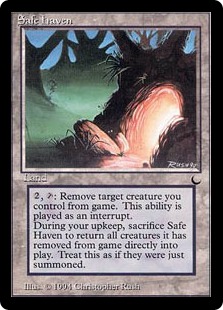For many players, land is one of the least interesting components of Magic: the Gathering. Most see them as a necessary evil, a means to get out the other cards that they actually want to use. After all, what is there to get excited about with cards that do little by themselves and take up at least a third of your deck?
Depending on who you ask, potentially a lot.
While it’s true that the Basic Five are pretty unassuming, land itself doesn’t have to be boring. Entire mechanics have been based off putting land onto the battlefield, and a tournament-winning deck archetype was based off of Valakut, the Molten Pinnacle not that long ago. Indeed, from the game’s very inception, nonbasic land has caught the attention of tournament and casual players alike.
Case in point: What do the lands Bazaar of Baghdad, Island of Wak-Wak, and Eye of Ugin all have in common?
For much of Magic’s history, all land had to do one of two things: tap for mana and / or provide some sort of ability. Nonbasic lands that focus on mana are principally designed to produce more than one mana or more than one color (e.g. dual lands, Fetchlands, guildlands, Shocklands, etc.) These lands help players with mana fixing, ensuring that your deck has more reliable access to the mana you need. Ultimately, though, the purpose of these lands is on efficiency over versatility. Thus, while many of them – particularly the rares – are useful, most casual players groan if one of them ends up being their pack’s rare.
On the other hand, utility lands (those that do something besides tap for mana) are far more favorable. Examples of these are Springjack Pasture, High Market, or Kessig Wolf Run.
However, while utility lands of today also tap for mana, for quite a few years manaless land wasn’t unheard of. After a time, R&D got together and decided that all lands made going forward, with rare exception (looking at you Eye of Ugin), had to provide mana. Besides the fact that players were often confused by lands that didn’t add mana and shouldn’t be slotted in decks as such, Wizards wanted to reiterate the thematic aspects of what land were supposed to be. They are the physical representations of players drawing energy from their surroundings. Lands that provide an ability but not mana is essentially a harder to destroy artifact or enchantment.
In reality, the game offered a host of these manaless lands at one time, from the terrible (Adventurers’ Guildhouse), to the terribly expensive (The Tabernacle at Pendrell Vale), to the poster child of the landless in Maze of Ith. Nestled amongst them somewhere in the middle, though, is where we find ourselves this week.
Today we have: Safe Haven

Name: Safe Haven
Edition: The Dark / Chronicles / Time Spiral Timeshifted
Rarity: Rare
Focus: Creature Removal / Creature Recursion
Highlights: Safe Haven didn’t quite get the same fanfare as the powerhouse lands of its day, but it has still seen its share of proponents over time. Safe Haven is a remarkably effective and versatile card for saving your creatures, but it during its original tenure it wasn’t without problems. Namely, it was the type of card that made an excellent Stone Rain target, and since it existed during a period when land destruction was far more potent, it was risky to heavily rely on its use.
But times, they have ‘a changed. Between the decrease in easy land destruction and EDH being a slower format, Safe Haven can once again live up to its namesake. Most have seen this card’s effect on its slightly less restrictive descendant Synod Sanctum. Admittedly by comparison Safe Haven seems weaker since it can only exile creatures and the return trigger occurs during your upkeep, but Safe Haven is also far more likely to have its fare survive a board wipe – which is sort of the card’s job.
Safe Haven also has the distinction of being the third card ever created with an Oblivion Ring-style effect (after Oubliette and Tawnos’s Coffin), and the first that could affect more than one creature. What’s more, even with all of the different variant cards that exist now, Safe Haven’s ability to be added to any deck – especially colors that aren’t particularly good at saving their own creatures – helps this card find a resurgence in the Commander scene.
For low, low cost of zero mana and utilizing the same slot as a comparable artifact, Safe Haven is a safe choice. The fact that it can’t be tapped for mana and has a timing restriction on recursion may cause some to scoff, but this indirectly avoids drawing attention to this veteran card. The ability to exile one of your own creatures in response to some wrath or spot removal effect and then drop it back out the following turn for free is situational but incredibly worthwhile – and doubly so if no one sees it coming.
Keep an eye out for us to be regularly featuring other more accessible-but-worth-it Commander cards going forward. In the meantime, we’ll keep the light on for you.
![]()
You can discuss this article over on our social media!
Do you have a particular Commander card to suggest for us to shine a future Spotlight on? You can send suggestions to ryan@cardboardrepublic.com
